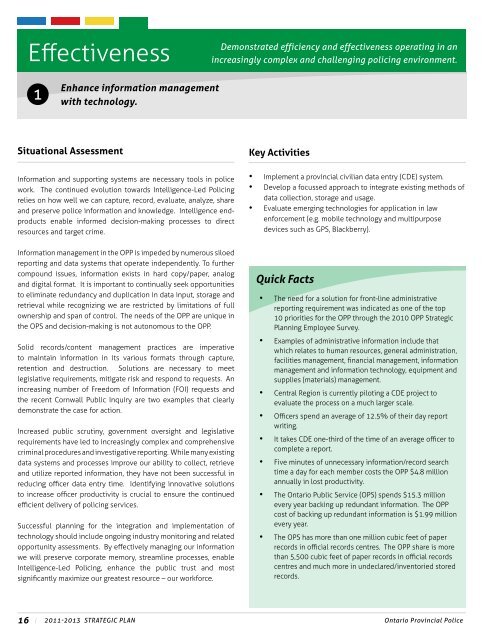OPP Strategic Plan - Police provinciale de l'Ontario
OPP Strategic Plan - Police provinciale de l'Ontario
OPP Strategic Plan - Police provinciale de l'Ontario
You also want an ePaper? Increase the reach of your titles
YUMPU automatically turns print PDFs into web optimized ePapers that Google loves.
Effectiveness<br />
1<br />
Enhance information management<br />
with technology.<br />
Situational Assessment<br />
Information and supporting systems are necessary tools in police<br />
work. The continued evolution towards Intelligence-Led Policing<br />
relies on how well we can capture, record, evaluate, analyze, share<br />
and preserve police information and knowledge. Intelligence endproducts<br />
enable informed <strong>de</strong>cision-making processes to direct<br />
resources and target crime.<br />
Information management in the <strong>OPP</strong> is impe<strong>de</strong>d by numerous siloed<br />
reporting and data systems that operate in<strong>de</strong>pen<strong>de</strong>ntly. To further<br />
compound issues, information exists in hard copy/paper, analog<br />
and digital format. It is important to continually seek opportunities<br />
to eliminate redundancy and duplication in data input, storage and<br />
retrieval while recognizing we are restricted by limitations of full<br />
ownership and span of control. The needs of the <strong>OPP</strong> are unique in<br />
the OPS and <strong>de</strong>cision-making is not autonomous to the <strong>OPP</strong>.<br />
Solid records/content management practices are imperative<br />
to maintain information in its various formats through capture,<br />
retention and <strong>de</strong>struction. Solutions are necessary to meet<br />
legislative requirements, mitigate risk and respond to requests. An<br />
increasing number of Freedom of Information (FOI) requests and<br />
the recent Cornwall Public Inquiry are two examples that clearly<br />
<strong>de</strong>monstrate the case for action.<br />
Increased public scrutiny, government oversight and legislative<br />
requirements have led to increasingly complex and comprehensive<br />
criminal procedures and investigative reporting. While many existing<br />
data systems and processes improve our ability to collect, retrieve<br />
and utilize reported information, they have not been successful in<br />
reducing officer data entry time. I<strong>de</strong>ntifying innovative solutions<br />
to increase officer productivity is crucial to ensure the continued<br />
efficient <strong>de</strong>livery of policing services.<br />
Successful planning for the integration and implementation of<br />
technology should inclu<strong>de</strong> ongoing industry monitoring and related<br />
opportunity assessments. By effectively managing our information<br />
we will preserve corporate memory, streamline processes, enable<br />
Intelligence-Led Policing, enhance the public trust and most<br />
significantly maximize our greatest resource – our workforce.<br />
Demonstrated efficiency and effectiveness operating in an<br />
increasingly complex and challenging policing environment.<br />
Key Activities<br />
Implement a provincial civilian data entry (CDE) system.<br />
Develop a focussed approach to integrate existing methods of<br />
data collection, storage and usage.<br />
Evaluate emerging technologies for application in law<br />
enforcement (e.g. mobile technology and multipurpose<br />
<strong>de</strong>vices such as GPS, Blackberry).<br />
16 | 2011-2013 <strong>Strategic</strong> <strong>Plan</strong> Ontario Provincial <strong>Police</strong><br />
•<br />
•<br />
•<br />
Quick Facts<br />
•<br />
•<br />
•<br />
•<br />
•<br />
•<br />
•<br />
•<br />
The need for a solution for front-line administrative<br />
reporting requirement was indicated as one of the top<br />
10 priorities for the <strong>OPP</strong> through the 2010 <strong>OPP</strong> <strong>Strategic</strong><br />
<strong>Plan</strong>ning Employee Survey.<br />
Examples of administrative information inclu<strong>de</strong> that<br />
which relates to human resources, general administration,<br />
facilities management, financial management, information<br />
management and information technology, equipment and<br />
supplies (materials) management.<br />
Central Region is currently piloting a CDE project to<br />
evaluate the process on a much larger scale.<br />
Officers spend an average of 12.5% of their day report<br />
writing.<br />
It takes CDE one-third of the time of an average officer to<br />
complete a report.<br />
Five minutes of unnecessary information/record search<br />
time a day for each member costs the <strong>OPP</strong> $4.8 million<br />
annually in lost productivity.<br />
The Ontario Public Service (OPS) spends $15.3 million<br />
every year backing up redundant information. The <strong>OPP</strong><br />
cost of backing up redundant information is $1.99 million<br />
every year.<br />
The OPS has more than one million cubic feet of paper<br />
records in official records centres. The <strong>OPP</strong> share is more<br />
than 5,500 cubic feet of paper records in official records<br />
centres and much more in un<strong>de</strong>clared/inventoried stored<br />
records.



